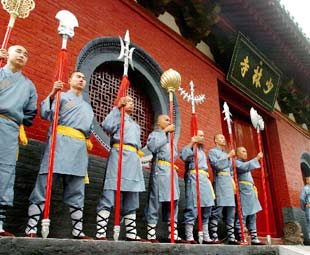| Tools: Save | Print | E-mail | Most Read |
| Shaolin Spirit Takes Root Abroad |
| Adjust font size: |
The Shaolin Temple has long been a symbol of religious serenity and Chinese martial arts or kungfu. With a growing international enthusiasm for Chinese kungfu in recent years, Shaolin Temple branches have taken root outside of China, started either directly by the main Shaolin Temple in China or by its disciples. In addition to martial arts training, these overseas branches are giving disciples an introduction to the profound culture that is Chinese kungfu.
Journalists from Banyue Tan (Fortnightly Review) recently visited two such overseas Shaolin Temple branches; one in New York, USA, and the other in Budapest, Hungary. Shaolin NYC Located on 41st Avenue, Flushing District, the Shaolin Temple in New York, covering a total area of 750 square meters, was set up in 1995 by Master Guolin, the Dharma heir of the 30th abbot of Shaolin. Today, it has about 400 disciples, half of whom are of Asian descent. Of these disciples, three are monks and the others lay disciples. The lay disciples are as young as four or five, and as old as 70. Contrary to popular belief, Shaolin disciples are a mix of monks, lay disciples (su jia di zi) and warrior monks (wu seng.) Unlike the fully fledged Shaolin monks, lay disciples and warrior monks do not take all ten Buddhist vows. What stands out about the New York branch is the fact that it has female disciples. Master Guolin said: "Anyone who loves Shaolin kungfu, regardless of their religious background, can be our disciple." Master Guolin admitted that what motivates most foreign disciples to join Shaolin is kungfu. However, he found that they gradually develop an interest in the deeper meaning of kungfu during the course of their training. He explained that the Shaolin culture is a part of traditional Chinese culture, which includes the art of Zen, martial arts, and traditional medicine. Shaolin doesn't only teach kungfu; it also provides guidance on solving everyday practical problems through its Buddhism and Zen teachings. The New York Shaolin Temple is also actively involved in charity. Under Master Guolin's leadership, the Shaolin Kungfu Performance Group regularly organizes fundraisers to help poor children attend school and in support of disaster relief. In addition, Master Guolin conducts self-defense classes for non-Shaolin members. Shaolin Temple, Budapest Twenty kilometers northeast of Budapest is the Shaolin Kungfu Training Center. Its entrance is an exact replica of the Shaolin Temple in China, resplendent with its red walls, gray tiles and distinctive Chinese design. The center was set up in 1998 by an American Hungarian. In 1999, Shi Xinghong, a 32nd generation Shaolin monk, left his teaching post in Italy to take over the Hungarian center, which has trained more than 20,000 foreign disciples. The Hungarian government has lent enormous support to the center, which includes a 1,000-square-meter piece of land that it gave to the center, free of charge. In 2003, the government invited Master Shi to lead the training of the Hungarian elite police force. The center employs 20 martial arts coaches, most of whom have been practicing kungfu for more than 10 years. They give lessons at the center from eight to 10 in the morning before going out to schools and sports clubs. There are also night classes for those who work during the day. Martial arts levels in Hungary are among the highest in Europe, with Hungarian exponents having won more than 500 prizes and trophies in international martial arts competitions. The talented pugilists who win the top three places at the annual national Chinese martial arts competition are sent to China to experience life at the original Shaolin Temple, sponsored by the center. In addition to kungfu, Master Shi also teaches Chinese philosophy and culture basics, typically in the last 20 minutes of every class, including teachings in Zen, Taoism and Confucianism. For a more in-depth study of Chinese culture, students can attend summer camps and retreats that include lessons on tea culture, Chinese calligraphy and traditional Chinese medicine. (China.org.cn by Wang Qian, November 5, 2006) |
| Tools: Save | Print | E-mail | Most Read |
 |
| Related Stories |
